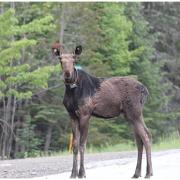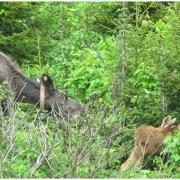The deer hunting seasons are fast approaching!
By Wildlife Biologist, Deer Specialist, Nathan Bieber

Maine’s Dynamic Moose Study: An Overview of Maine’s Seasonal Moose Research
Year round, Maine Department of Inland Fisheries and Wildlife biologists are going above via helicopters and beyond on ATVs, boats, snowmobiles and foot to implement several adaptive methods of population monitoring for Maine’s beloved and iconic mammal, the moose.
Managing for New England Cottontail in State Parks
By Wildlife Biologist Sarah Spencer
If you’re a regular reader of the MDIFW Blog, then you’re already familiar with the New England cottontail. If you’ve joined us more recently, welcome! Here’s a quick recap on some of the New England cottontail-themed blogs we’ve shared with you to date:

The Case of the Moose Spy
During calving season for moose, which runs from early May to early August when cows are weaning their calves onto a vegetarian and not solely milk-based diet, I have a group of spies in the woods.
Monitoring Maine's Peregrine Falcons
By Wildlife Promotional Coordinator Lauren McPherson
Recently, I had the opportunity to join one of my colleagues at the Maine Department of Inland Fisheries and Wildlife (MDIFW) in the field to do some monitoring of a peregrine falcon nesting site, as part of the Department’s ongoing statewide breeding monitoring program.
Building Wood Duck Boxes
By Regional Wildlife Biologist Chuck Hulsey
When you see a wooden box on a post over shallow water, with a hole in the front, you probably know that it is a nest box for wood ducks. But did you know Maine has other duck species that need tree cavities in order to nest and rear young? Though developed for wood ducks, they are commonly used by Hooded mergansers and American goldeneyes. “Wood duck boxes” may be the most recognizable wildlife management technique of all.
40 Ways to help conserve Maine’s reptiles, amphibians, and invertebrates – MDIFW Bicentennial Celebration
By MDIFW’s Reptile, Amphibian, and Invertebrate Group: Wildlife Biologist Phillip deMaynadier Ph.D., Wildlife Biologist Beth I. Swartz, and Wildlife Biologist Derek York
Our beautiful state is turning 200 this year! But Maine wouldn’t be “Maine” without our fish, wildlife, and recreation opportunities… Celebrate with us by learning 200 ways YOU can help conserve Maine for generations to come. Here are 40 ways you can help conserve Maine’s reptiles, amphibians, and invertebrates:
Keep In Touch!
Enter your email or mobile number to receive the latest news from MDIFW.